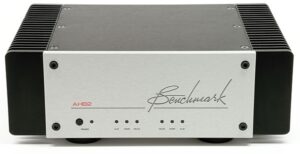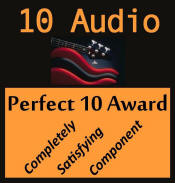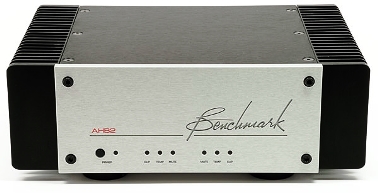The Benchmark AHB2 solid-state stereo power amplifier immediately grabbed the audio world’s attention about 7 years ago when it was introduced. Combining state of the art specifications, cutting-edge technology, and amazingly small size and light weight, the $2999 amplifier quickly became a must-audition. There are already a number of reviews, so the purpose of this one is to add another data point, another reaction to add to the knowledge base of this remarkable amplifier.
Just looking at the amplifier’s diminutive size of about 11 inches wide, 3.9 inches high, and 9.3 inches deep, and 12.5 pound weight will not prepare one for the quality of performance delivered by the nicely finished package. Rated at 100 Watts per channel into 8 Ohms, 190 Watts into 4 Ohms, or, when switched to a single channel, mono amplifier for 380 Watts into 8 Ohms. Benchmark publishes a very complete set of specifications, which are still top-drawer. Especially noteworthy are the following:
132 dB A-weighted Signal-to-Noise ratio Frequency response better than 0.1 Hz to 200 kHz, -3 dB Adjustable input sensitivity assures compatibility with any stereo system Trigger connections Full protection against shorts, distortion, over current, and over temperature Worldwide voltage compatibility XLR inputs. Unbalanced (RCA) cables require RCA-F to XLR-M adapters, pin 2+
One might well assume that due to these specs the amplifier is some kind of Class D “digital” tech. Not so! The amplifier has a low-bias bipolar class AB output stage which produces far less heat than most other amplifier bias schemes, especially those with high bias Class A output stages. The key to the small size and weight is the “tightly regulated resonant switching power supply”, which is claimed to be over 90% efficient. A switching power supply does not require “big iron” power transformers and large capacitors.
Other significant technologies include patented THX-AAA feed forward error correction. This is critical to the excellent sound of the amplifier as it eliminates crossover distortion, the common bane of push-pull amplifiers. The result is the sonic purity of a single-ended amplifier with much greater power output and dynamic capability.

Other components on hand during the audition include a VPI Aries 3 turntable with a Kuzma 4-Point or Tri-Planar VII SE tonearm, Holbo Turntable System, Clearaudio Ovation turntable with Universal tonearm; ZYX UNIverse Optimum and Miyajima Madake moving coil cartridges; B.M.C. MCCI ULN and Aurorasound VIDA Prima phono preamplifiers; custom Windows 10 music computer running JRiver Media Center; Wyred 4 Sound DAC 2v2SE 10th Anniversary DA converter; RME ADI-2 Pro AD/DA converter with external power supply; Pass Labs XP-22, BAT VK-43SE, and Wyred 4 Sound STP-SE Stage 2 preamplifiers; Valvet E2 SE, Wyred 4 Sound ST-750LE, Cary SA-200.2 ES, and Mivera 1200AS2 power amplifiers; Magico S1 mk.2 loudspeakers with the low bass, <40, engaged by a pair of JL Audio e110 subwoofers, Focal Chorus 714 and Dynaudio Evoke 30 loudspeakers borrowed from the HT system. The audio cabling is Audioquest WEL Signature, MIT MA-X SHD, Cardas Clear Beyond and Mogami interconnects and speaker cables. USB cables are Straight Wire USB-F. Power protection and purification are provided by an Audioquest Niagara 5000 or PS Audio Dectet for the preamplifiers and source components, and a PS Audio Quintet for the power amplifiers. The Quintet includes a standard 1/8″ trigger for remote turn-on and -off of power amplifiers that lack a 12V remote trigger. Power cords include my DIY power cord, Straight Wire Pro Thunder, and Audioquest Blizzard 20A (for the Niagara 5000).
The AHB2 requires significant break in to sound its very best. Although it sounds good when brand new, notes can occasionally sound somewhat broken and discontinuous. At 75 hours of use, the sound is improved. After 200 hours, break in is mostly complete, and evidenced by the perception that musical notes are floating in air. There did not seem to be any further changes after 500 hours. Note: These intervals are a notation only, and it is suspected that louder average system volume would reduce these times.
An initial concern with any new design, attributable to the vastly different tonal perspectives of different amplifier technologies, regards the accurate delivery of high frequency content. Class D amplifiers, including the latest IcePower IceEdge, seem to edit linear treble response, sounding limited in their extension and ultimate resolution: relatively dark. Immediately upon cuing up the first musical selection, it was perfectly obvious that the AHB2 has outstanding extension in the upper treble, seemingly unlimited. In this regard, the Benchmark amplifier should be compared to excellent Class A or AB amplifier technology.
However, the AHB2 lacks the characteristic, almost subliminal harshness in the upper frequencies that is observed in some push-pull amplifiers, but absent in single-ended amplifiers. This is possibly a cause of dissatisfaction with many of these amps and why we see a constant turnover of amps in the $2,000-15,000 range. You already know the models because we see new listings almost every day for them on Audiogon and Audio Mart.
The bass has outstanding definition, with just slightly less dynamic power in the lowest bass, below about 30 Hz, as a big solid state amp might perform. Of course, this is very much related to the loudspeaker and the listening room. The AHB2 is not at all deficient in the bass. This observation is just comparative, not qualitative. This observation is also nitpicky, relevant to a review, and possibly unreliable in a different system.
The overall sound is very true to the recording with regular ‘virtual reality’-like experiences. These last for long periods of a listening session, not just as a momentary feeling of great sound. This is due to the exceptional linearity across the musical spectrum. The coherence and resolution of all sounds – which have stunning low level resolution – is special, encouraging the listener to maximally enjoy a musical performance. This used to be called “digging it”.
The imaging and sound stage is 3D, large and stable. It is a simple exercise to point a finger directly at a performer, even when many are present in the virtual sound stage. The sonic image is remarkably focused and apparent.

The Benchmark amplifier’s dynamic performance is exemplary. I value my hearing and enjoy listening at average sound pressure levels (SPLs) around 80 dB, which gives peaks reaching 105 dB. At these levels with the 86 dB sensitivity of the Magico speakers, the amplifier’s front panel clipping/fault indicator lights never lit up. The amplifier is barely warm to the touch. Both small, micro dynamic nuance and huge, explosive changes in volume are always delivered with a clearly defined leading edge and plenty of energy.
The one noticed character is entirely relative in nature to other power amplifiers. The AHB2 is more open and forward than the latest Class D, but in a good way. The Benchmark amp is slightly more upper-midrange-centric than the single-ended Class A Valvet E2 SE. The latter could be considered more lower-midrange-centric, relatively speaking. For the first 2-3 weeks after installing the AHB2, I missed the more relaxed, less urgent sound of the Valvet amp, going back to it often. But after a month or so, I realized that the Valvet amp had not been substituted in quite a while. Clearly, as both me and the Benchmark amplifier broke in, my mental benchmarks for great sound had adjusted a bit to accommodate the small difference in perspective that the Benchmark amplifier offers. It is important to repeat that the differences were “a little more of this, a little less of that”, but never related to quality. Both are fine amps and beautiful sounding. This difference in perspective could be compared to changing your seat at an acoustic concert from row 20 to row 2.
In order of this “forwardness” or treble apparent character, the Benchmark is first, closely followed by the Valvet E2 SE, with a Mivera IcePower IceEdge amp offering the “darkest” presentation.
The Valvet E2 SE is a very fine amplifier, but not the best match for the Magico speakers. While the amp can manage SPLs in the mid 70 dB SPL range, the sound becomes compressed as the volume nears its 20-Watt power rating. Below that volume level, the single-ended amp is still slightly purer and more nuanced. Above that level, the AHB2 takes over with great competence and pulls ahead in power and dynamics at more normal listening levels. The Benchmark amplifier sounds better louder.
At the end of this audition, the stock fuses were replaced with Audio Horizons Platinum Reference fuses. With these installed, the Benchmark amp paced the E2 SE at lower volumes, too. The special character of super-pure tones and rich harmonics that allowed the Valvet amplifier to maintain a small lead was now a matching feature of the AHB2. This is often called “Having your cake and eating it, too!”. We really do get the purity of Class A single-ended with the power of Class AB push-pull. Amazing! A Synergistic Research Orange fuse was also tried, but it made the amplifier sound worse than the stock fuse.
The Benchmark AHB2 is a very fine sounding, easy to live with, zero-maintenance power amplifier that has enough power for most systems. If more power is needed, two amplifiers configured for mono can provide it. The decision to purchase the review sample and make the Benchmark AHB2 a new, long term reference took over a month of listening and comparisons. This long audition is actually a good thing, since components that offer immediate “improvements” are usually the ones that become tiresome in short order. The outstanding musicality of the Benchmark AHB2 amplifier takes some time to convince the listener of its wholly musical presentation. This subtle excellence assures long term satisfaction.
Overall Rating: 10 LPs

Link to manufacturer: Benchmark Media Systems
This review would not have been possible without the very kind support of Rory Rall at Benchmark Media Systems. Thank you, Rory!
Manufacturer’s Response:
Thank you for spending so much time with our AHB2 power amplifier. Your long-term impressions echo the comments we receive from many of our customers. The more time they spend with the AHB2, the more they appreciate the transparency of the amplifier. Once they have discovered this natural sound, they often find they cannot go back to traditional amplifiers.
Like class-A amplifiers, the AHB2 renders low-level details without the crossover distortion artifacts that are often produced by traditional class-AB amplifiers. Unlike class-A amplifiers, the AHB2 stays clean at high output levels while driving difficult loads. The AHB2 delivers the low-level performance of a class-A amplifier and the high current, high power, and high damping factor of a class-AB amplifier. The AHB2 delivers the best of both topologies because it combines both topologies. In the AHB2, a low-power class-A feed-forward correction amplifier, runs in parallel with a high-power class-AB amplifier. The feed-forward amplifier keeps the class-AB amplifier clean without the need for excessive feedback.
As you noted, class-AB artifacts often add harshness to traditional amplifiers when they are playing at low levels. These artifacts are entirely absent from the AHB2. This difference may be immediately noticeable to some listeners, but they may perceive this lack of distortion as a change in frequency response. When their ears have had time to adjust to the difference, they find that it is hard to go back. On the basis of measurements, the amplifier itself does not have a break-in period. I believe it is our ears that account for these ancedotal AHB2 break-in periods.
There is another distinct difference in the AHB2. Its phase response is extremely linear over the audible frequency range. This linearity is achieved by extending the frequency response well below and above the range of human hearing. The -3 dB bandwidth is 0.1 Hz to 250 kHz. This keeps the phase response extremely accurate between 20 Hz and 20 kHz. The result is that all frequencies are delivered to the speaker terminals at the proper time. In contrast, most amplifiers deliver the midrange before the extreme low and high ends of the audio band.
The AHB2 has a very low output impedance (high damping factor). This keeps the frequency and phase response linear while driving difficult loads. The high damping factor keeps the frequency response accurate to better than 0.1 dB at the amplifier terminals while driving speakers. This is especially important near the driver crossover frequencies. Amplifiers with lower damping factors often create audible changes in the system response.
John Siau, V.P., Benchmark Media Systems, Inc.

